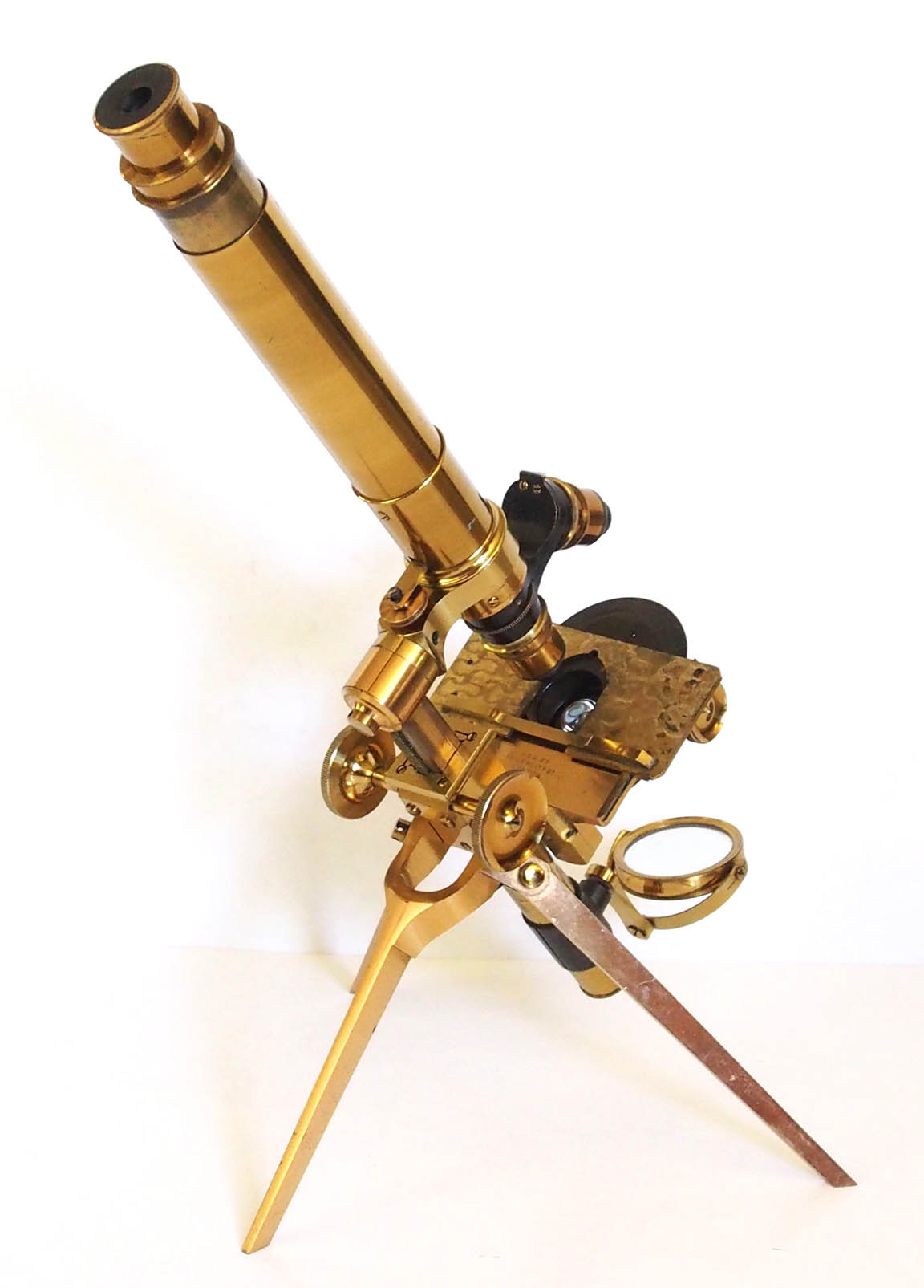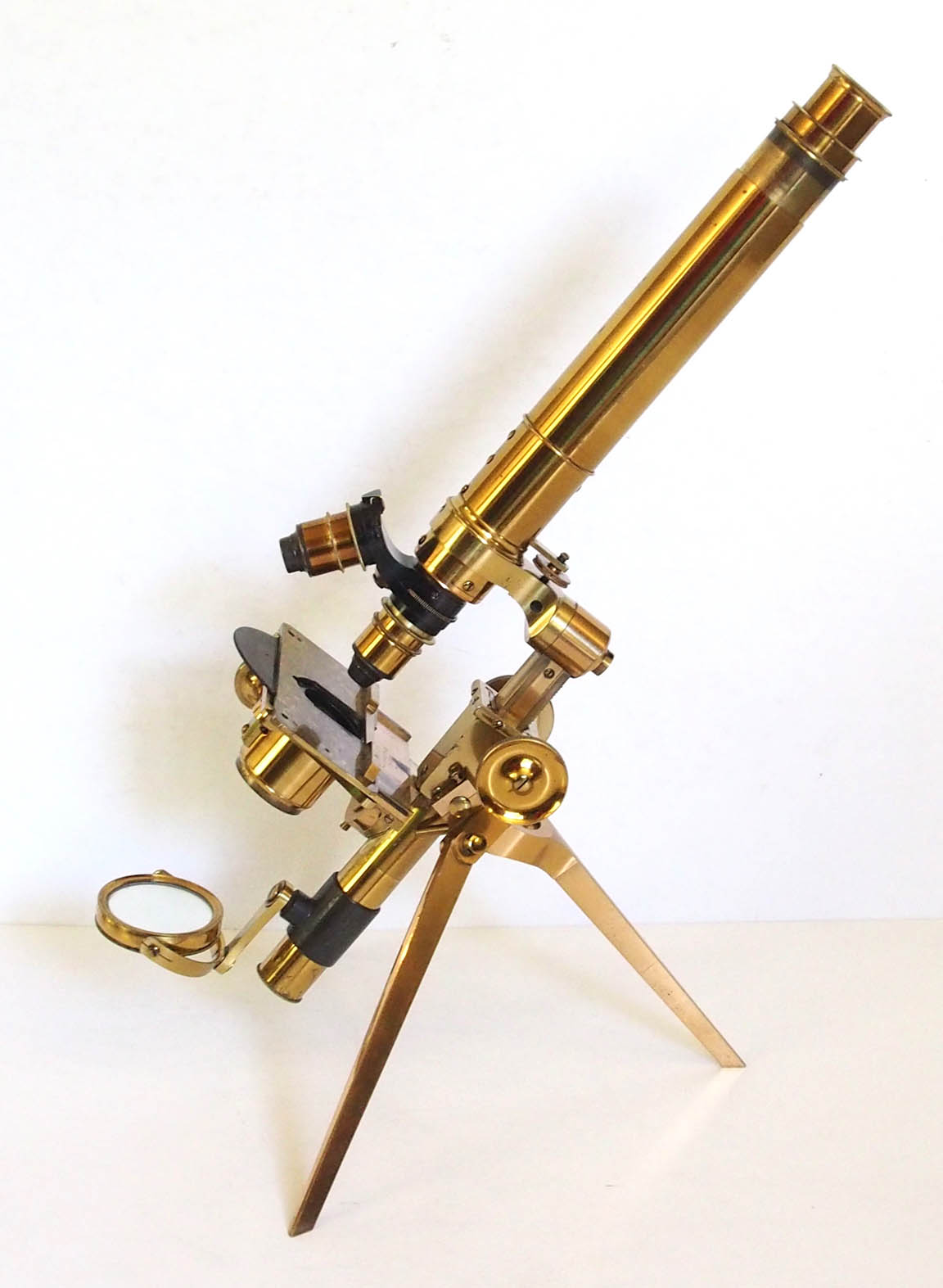COMPOUND FOLDING PORTABLE MICROSCOPE
MAKER: JAMES SWIFT & SON
c. 1877-1879
AUTHOR: Jurriaan de Groot
EDITOR: Joseph Zeligs
| DESCRIPTION | HISTORY |
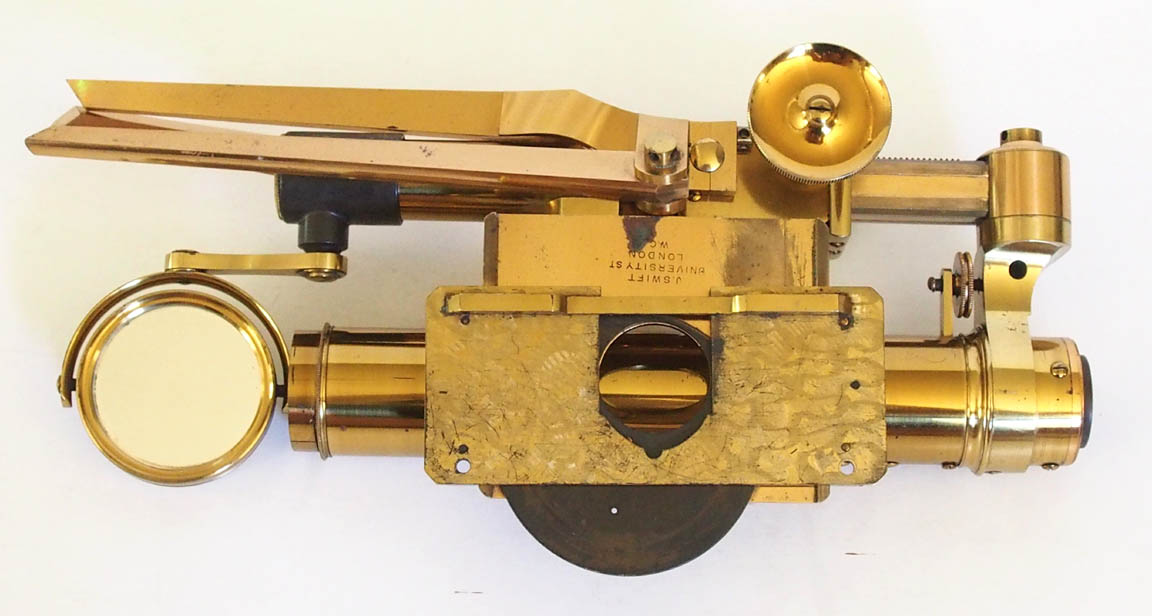
DESCRIPTION:
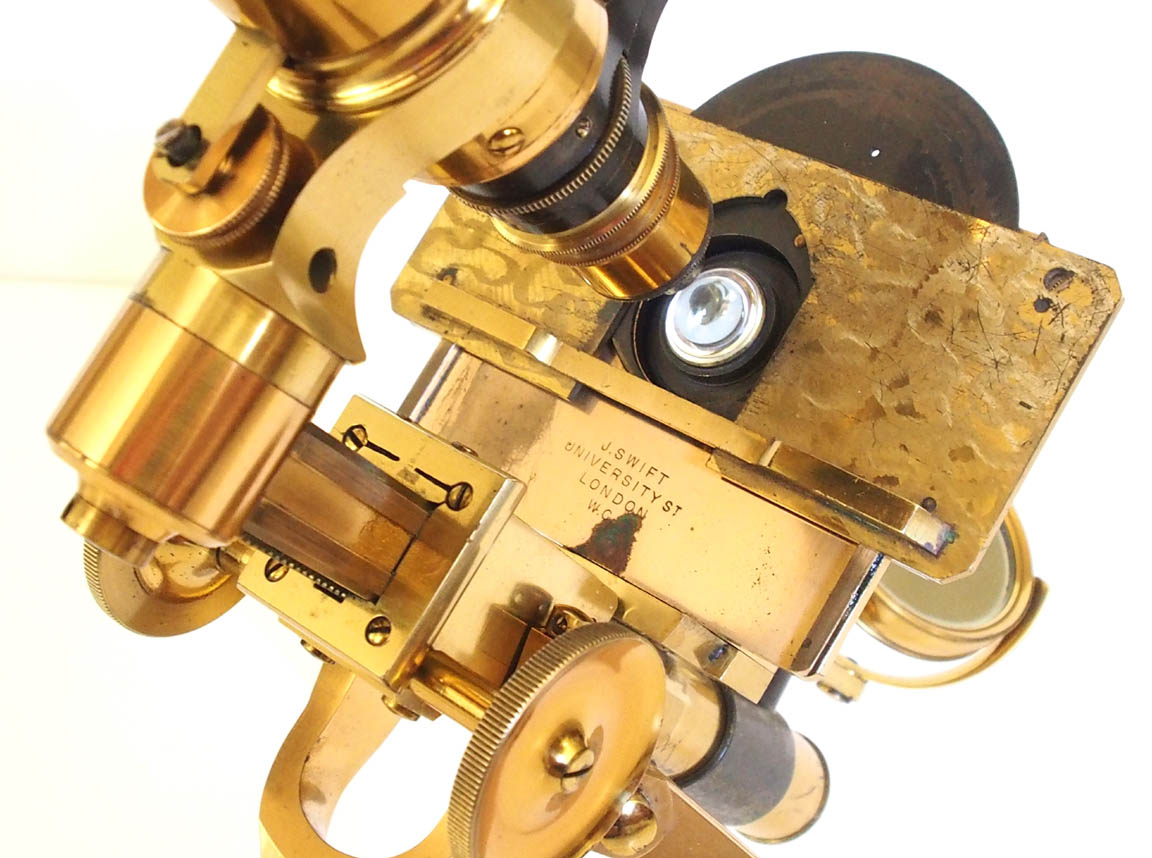
This is a very well preserved example of the monocular version of Swift's Portable compound microscope, and is signed on the stage: J. Swift, University St, London, W.C.
, an address the firm occupied between 1877 and 1881. The tripod stand is fitted with folding legs, the front two of which measure 150 mm in length, while the single rear leg ends in a fork at the top, which surrounds the pinion box. These joints can all be tightened using a small Tommy-bar
(which is is a rod fitting into the holes of the capstan bolts such as those of the folding legs).
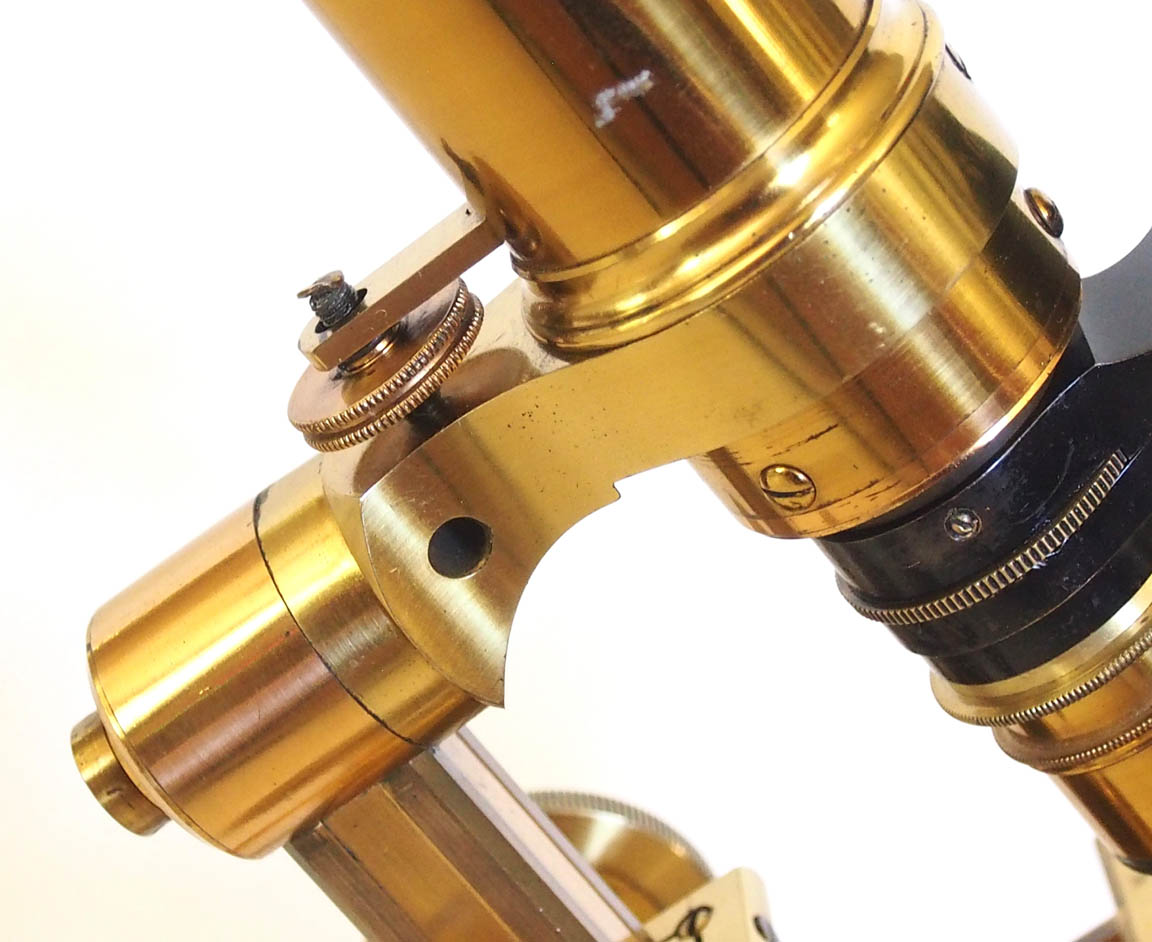
Coarse focus is by rack and pinion acting on a square limb which, at its top end carries a swivelling joint, allowing for the body tube to be rotated through 180 degrees, in order to achieve compactness for packing. The optical tube is 175 mm long, and carries a sliding tube to vary tube length. Eye piece diameter fit is 27.8 mm. Fine adjustment is by means of a small milled knob just behind the tube, and acting on the nose piece. A tubular tail piece extends below the square pinion box and carries a gimballed plano-concave mirror on a single arm at its lower end, while more proximally it has a bracket attached to it, which carries the stage, which can be rotated 90 degrees from its normal horizontal position to vertical, rendering the microscope flatter for packing. The stage measures 78 x 62 mm and for the Y-motion has a sliding top plate measuring 103 x 43 mm, which can be moved by hand, while the X- motion is achieved by moving the slide itself while resting against a brass bar at the rear of the top plate.
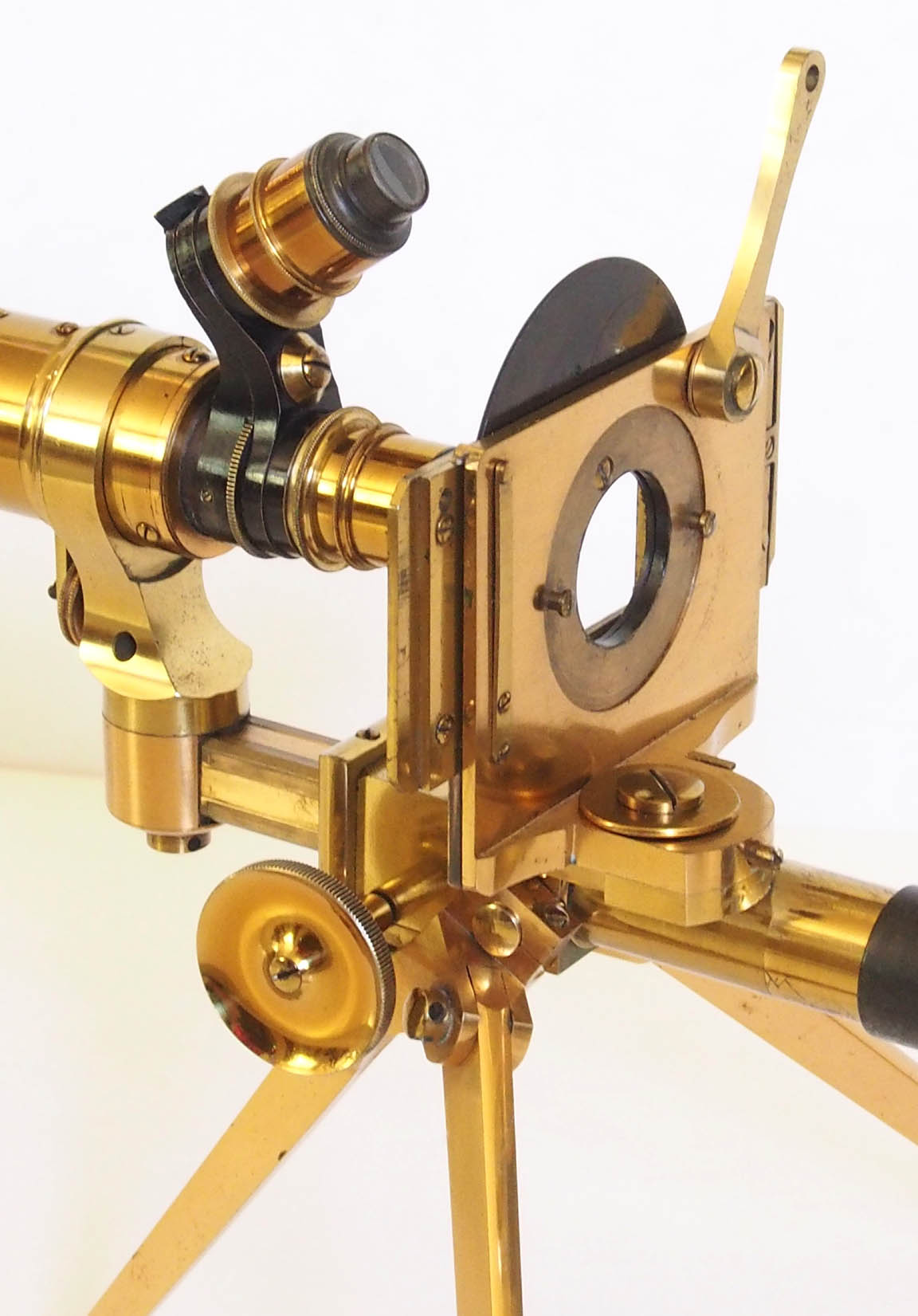
The stage carries a swing-out arm on its botttom to hold stage forceps, while an aperture is also present in the arm holding the body tube, to accomodate a stage condenser (both no longer present on this example).

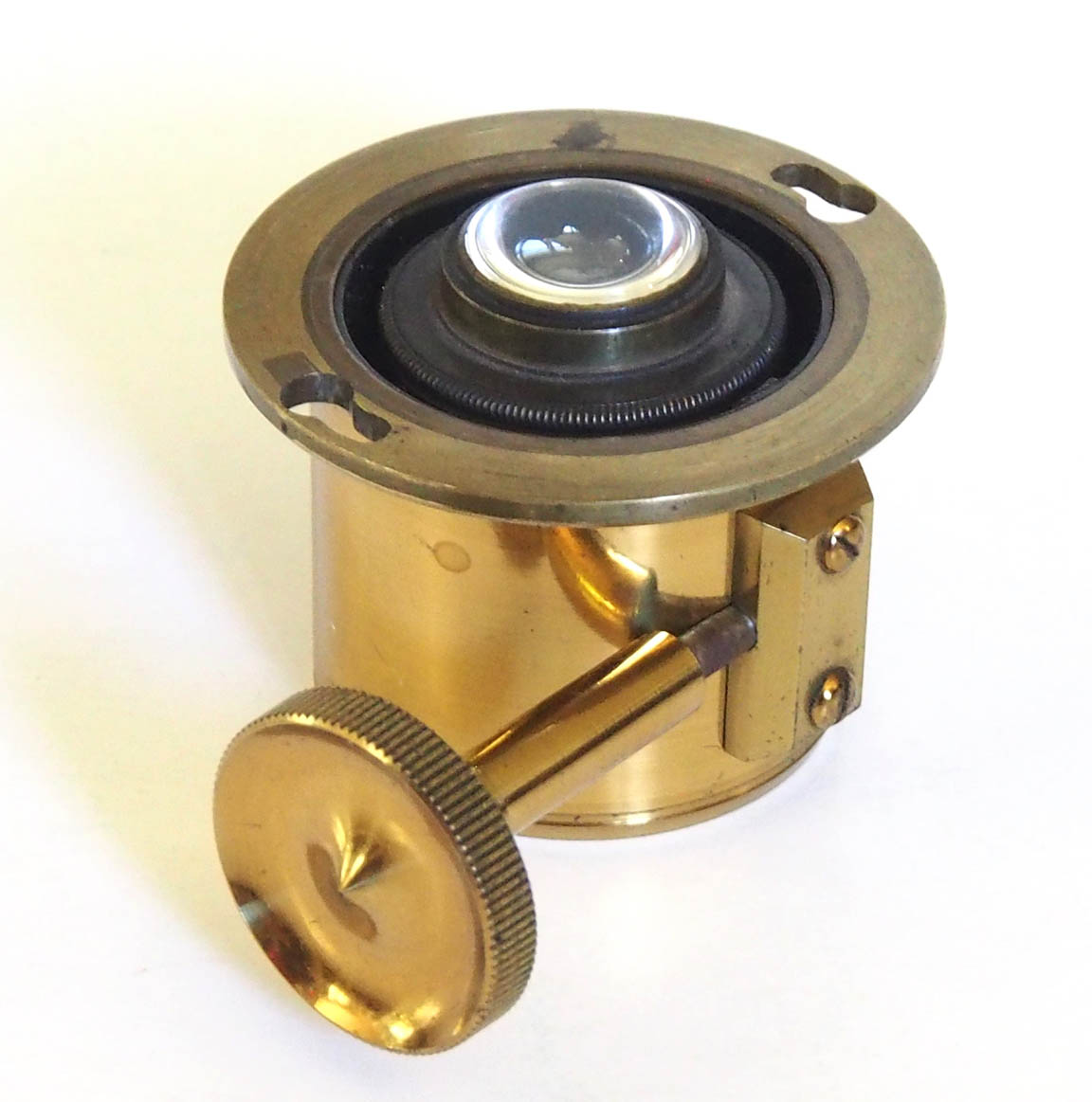
Attached to the bottom of the stage is the condenser housing, which affixes to it via a bayonet mechanism, and is focused by means of a single knurled knob operating an integrated rack and pinion. The optical part corresponds with a description of Swift's achromatic condenser, with a removable top lens, and with a blue filter screwed into its bottom. There is a large disc of apertures, which is recessed into the stage itself just underneath its top plate. This provides three circular apertures of different sizes and one to produce oblique lighting. This arrangement is not pictured in the 1876, 1880 nor 1892 Swift catalogs.
CASE:
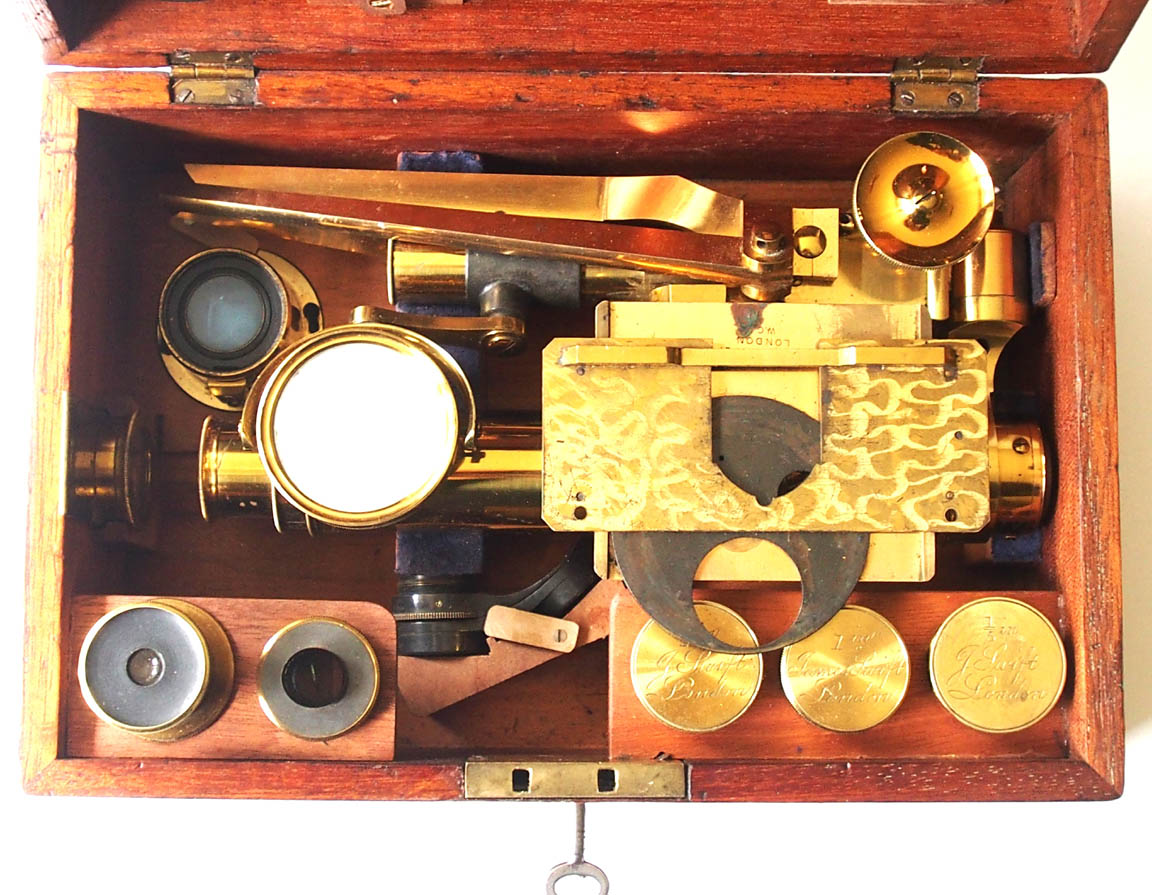
Although when purchased,the original case for this microscope was lacking, an antique case, left, was procured and fitted for the microscope. Images of some of the original cases offered can be seen below in the History section of this web page.
ACCESSORIES
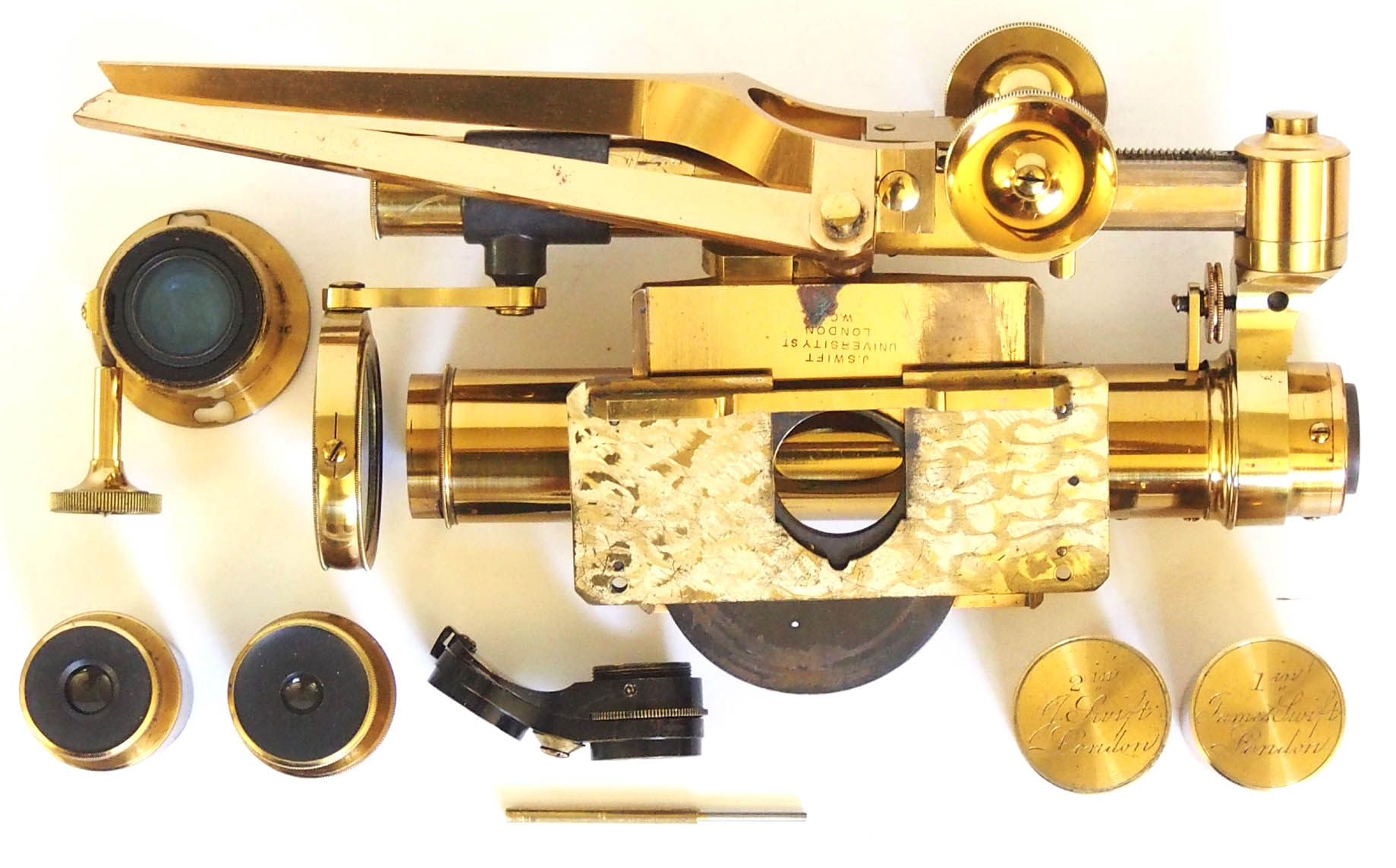 When acquired, there was one top hat 5X eyepiece, and a 1 inch Swift objective in matching can with this instrument. The present owner has since added a period 10X eye piece, a 2 inch Swift objective in matching can, a 1/2 inch Swift objective, and a correct Swift-type double objective changer to the set.
When acquired, there was one top hat 5X eyepiece, and a 1 inch Swift objective in matching can with this instrument. The present owner has since added a period 10X eye piece, a 2 inch Swift objective in matching can, a 1/2 inch Swift objective, and a correct Swift-type double objective changer to the set.
CONDITION
When purchased, the bracket holding the stage had become detached from the tail piece, and was re-affixed with a correct set of screws after tapping new thread. The original lacquer was in exceptionally good condition throughout, without much evidence of wear. As noted above, the original case was lacking but has been replaced with a period case.
HISTORY OF THE SWIFT PORTABLE MODEL MICROSCOPE
Inspired by Powell & Lealand's portable model microscope, first made in 1848, Swift introduced their folding portable in 1868. In their 1878 catalogue it was described as : This Microscope is so constructed that it can be readily set up for immediate use without the necessity of having to screw any part or parts together before using, a defect so often complained of in most Portable Microscopes, the whole of its joints and working parts are made to compensate for wear and tear, and when ready for use, as shown in fig. 1, is remarkably firm and steady under high magnifying power, it has sufficient coarse adjustment to work with the 5-in. objective, lever fine adjustment with central lift; the stage is very large and has an adjustable object carrier working upon glass bearings for smoothness of action whereby an object can be readily adjusted under a 1/16 objective, a ring is made to revolve in the centre of the stage by means of a small milled-head marked B for the purpose of rotating a selenite film when the instrument is used for polarised light, there are flat and concave mirrors mounted on a crank arm for oblique light, the optical tube of this instrument is of full size, with long divided draw tube, the whole folds up with eye piece as shown in fig. 2 and packs in a mahogany cabinet, 9 in. long, 4-in. wide and 2 1/4 in. deep.
The 1878 price for the monocular version was GBP 10, plus an extra GBP 4 10s. when provided with a Wenham binocular and an extra GBP 1 10s. for a case to hold the binocular version. Additional cost of an achromatic condenser, as provided with stops/selenites etc. for the larger Swift models was GBP 4 8s. In their 1892 catalogue, Messrs. Swift mention that their New Portable Binocular Microscope was exhibited at the 1878 Paris exhibition, where it was greatly admired by Jurors and other experts, who complimented the makers on the successful manner in which they had combined so many optical and mechanical perfections in such a limited space
.
.
Carpenter, in his 6th edition (1881) of The Microscope and its Revelations, also makes mention of this instrument: Swift's Portable Binocular- Carrying still further an idea originally worked out by Messrs. Powell and Lealand, Mr. Swift has devised a very complete Portable Binocular, which can be folded into a very small compass, without any screwing or unscrewing, and can thus be set up, as in Fig. 55A, or packed away, as at 55B, with great facility, when once the manner of doing so has been learned. Its construction is a marvel of ingenuity: while its workmanship is so excellent that its joints do not easily become loosened by wear, and can all be readily tightened when required. It is so steady as to bear being worked (as a monocular) with even high powers; but its great advantage consists in its suitability to the traveller, who either wishes (as often happens to the Author) to display to scientific friends in other countries a set of objects that can be most advantageously seen by the Binocular under low powers, or to avail himself of opportunities of examining on the spot any interesting specimens he may meet with. The instrument also carries Mr. Swift's Combination Sub-stage, which can be packed, together with three objectives, Side Condenser, and several other accessories, into a Case only 11 inches long, 6 1/2 inches wide, and 3 1/2 inches deep, the whole weighing only 7 1/2 lbs.
However, in the 7th edition (1891)of this seminal work, now edited by Dallinger, a less positive review is given of this microscope: Swift and Son subsequently made an instrument on similar lines (having described the P & L portable model earlier). The tripod and stage are packed practically as was Powell and Lealand's, but the stage in this case is plain. It carries a very convenient achromatic condenser, to which we call attention in its proper place; but its fine adjustment is so unsteady that it cannot be used with high powers for critical work. This instrument set up is seen in fig. 154, and in its packed condition is illustrated in fig. 155. The case in which this instrument is packed is 10 7/8 x 6 5/16 x 3 5/16 inches.
.
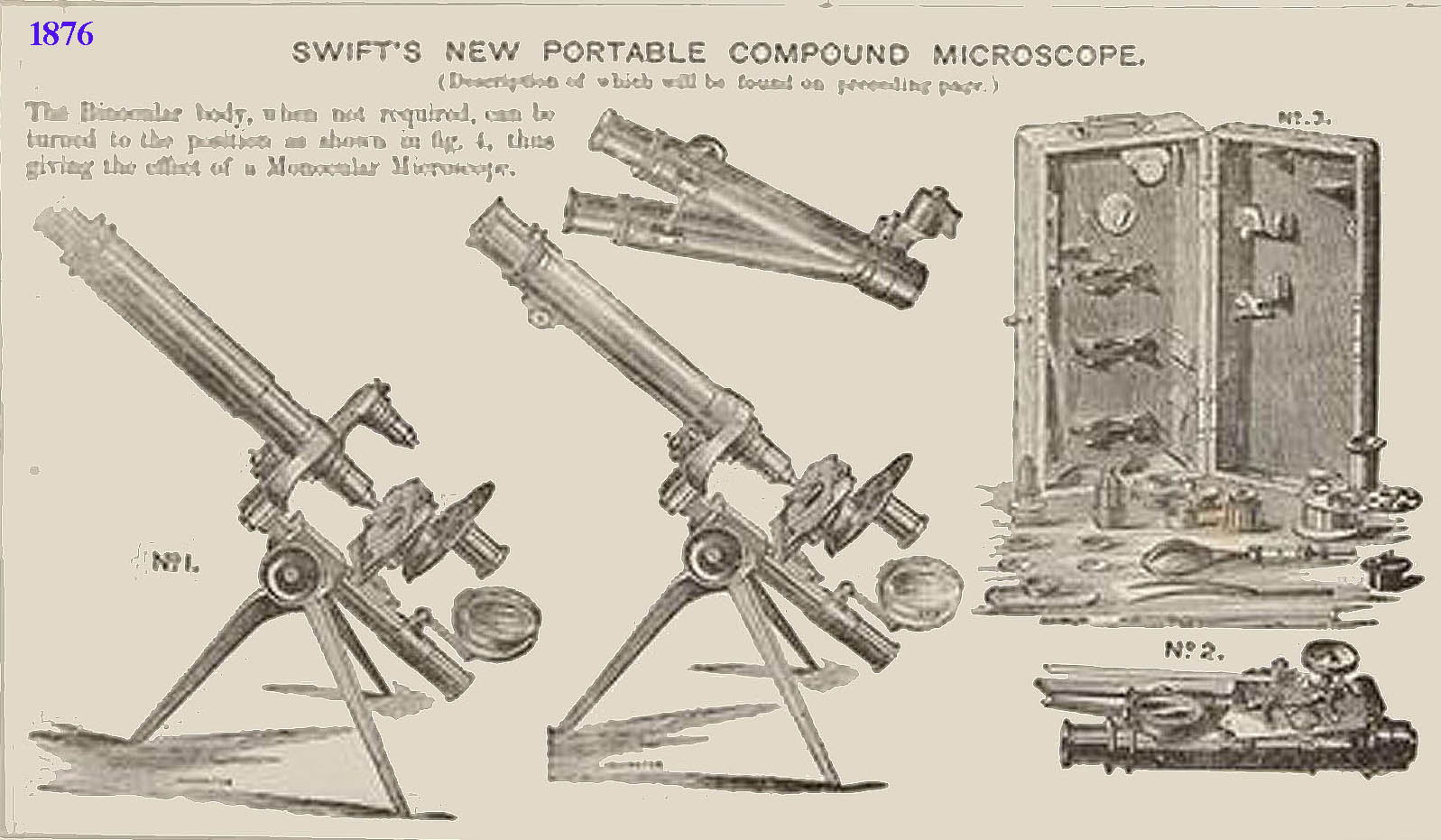
As shown in the 1876 catalog, as in this example, the microscope initially had a square stage, and substage apparatus attached to the bottom of the stage via a bayonet fitting. It was available both as a monocular and binocular. The binocular had both an analyzer and a Wenham prism built in to the binocular either of which could be slid out of the optical axis.
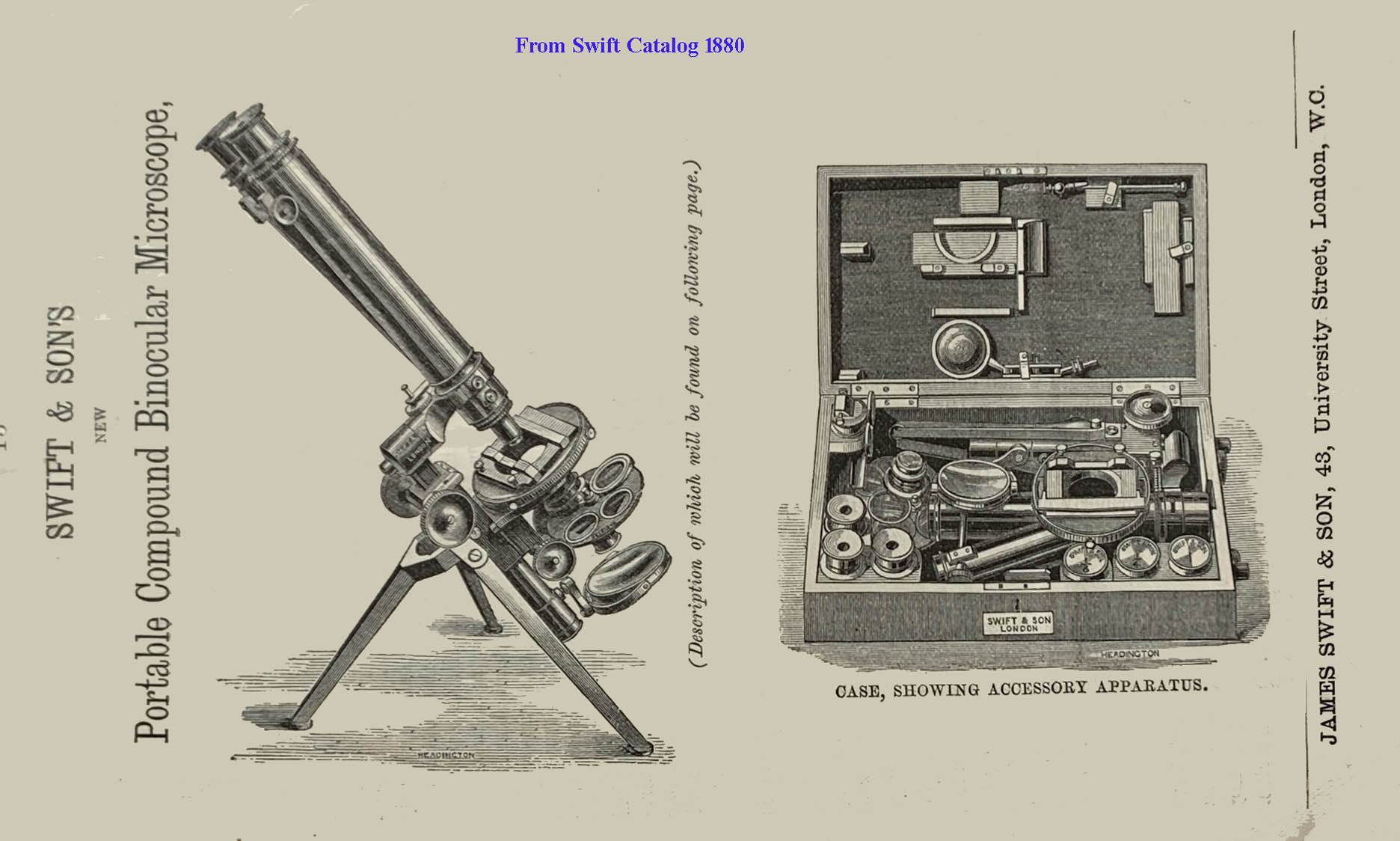
But by 1880, the catalogs show a circular stage and a rack and pinion focus to the newly pictured substage(optional for an extra £2 10s); attachment of accessories to the bottom of the stage was no longer required.

The 1892 Swift catalogue lists the same in monocular form, with plain sliding stage and 1 eye piece as costing GBP 10 0 0, but no mention is made of the set-up as in this particular example, fitted with a sub stage achromatic condenser, but having a disc of stops integrated into the stage.
It is therefore apparent, that this model went through a number of changes, including different versions of its stage and substage.
An example of a a later binocular version of this microscope, but featuring a racked substage and the Swift Universal Condenser, is in the Wisner collection.
For a more detailed history of the Portable Folding Microscopes, especially those by Swift, please see the history section of the later model Improved Clinical, Zoologist, and Field Microscope
.
DESCRIPTION:

This is a very well preserved example of the monocular version of Swift's Portable compound microscope, and is signed on the stage: J. Swift, University St, London, W.C.
, an address the firm occupied between 1877 and 1881. The tripod stand is fitted with folding legs, the front two of which measure 150 mm in length, while the single rear leg ends in a fork at the top, which surrounds the pinion box. These joints can all be tightened using a small Tommy-bar
(which is is a rod fitting into the holes of the capstan bolts such as those of the folding legs).

Coarse focus is by rack and pinion acting on a square limb which, at its top end carries a swivelling joint, allowing for the body tube to be rotated through 180 degrees, in order to achieve compactness for packing. The optical tube is 175 mm long, and carries a sliding tube to vary tube length. Eye piece diameter fit is 27.8 mm. Fine adjustment is by means of a small milled knob just behind the tube, and acting on the nose piece. A tubular tail piece extends below the square pinion box and carries a gimballed plano-concave mirror on a single arm at its lower end, while more proximally it has a bracket attached to it, which carries the stage, which can be rotated 90 degrees from its normal horizontal position to vertical, rendering the microscope flatter for packing. The stage measures 78 x 62 mm and for the Y-motion has a sliding top plate measuring 103 x 43 mm, which can be moved by hand, while the X- motion is achieved by moving the slide itself while resting against a brass bar at the rear of the top plate.

The stage carries a swing-out arm on its botttom to hold stage forceps, while an aperture is also present in the arm holding the body tube, to accomodate a stage condenser (both no longer present on this example).


Attached to the bottom of the stage is the condenser housing, which affixes to it via a bayonet mechanism, and is focused by means of a single knurled knob operating an integrated rack and pinion. The optical part corresponds with a description of Swift's achromatic condenser, with a removable top lens, and with a blue filter screwed into its bottom. There is a large disc of apertures, which is recessed into the stage itself just underneath its top plate. This provides three circular apertures of different sizes and one to produce oblique lighting. This arrangement is not pictured in the 1876, 1880 nor 1892 Swift catalogs.
CASE:

Although when purchased,the original case for this microscope was lacking, an antique case, left, was procured and fitted for the microscope. Images of some of the original cases offered can be seen below in the History section of this web page.
ACCESSORIES
 When acquired, there was one top hat 5X eyepiece, and a 1 inch Swift objective in matching can with this instrument. The present owner has since added a period 10X eye piece, a 2 inch Swift objective in matching can, a 1/2 inch Swift objective, and a correct Swift-type double objective changer to the set.
When acquired, there was one top hat 5X eyepiece, and a 1 inch Swift objective in matching can with this instrument. The present owner has since added a period 10X eye piece, a 2 inch Swift objective in matching can, a 1/2 inch Swift objective, and a correct Swift-type double objective changer to the set.
CONDITION
When purchased, the bracket holding the stage had become detached from the tail piece, and was re-affixed with a correct set of screws after tapping new thread. The original lacquer was in exceptionally good condition throughout, without much evidence of wear. As noted above, the original case was lacking but has been replaced with a period case.
HISTORY OF THE SWIFT PORTABLE MODEL MICROSCOPE
Inspired by Powell & Lealand's portable model microscope, first made in 1848, Swift introduced their folding portable in 1868. In their 1878 catalogue it was described as : This Microscope is so constructed that it can be readily set up for immediate use without the necessity of having to screw any part or parts together before using, a defect so often complained of in most Portable Microscopes, the whole of its joints and working parts are made to compensate for wear and tear, and when ready for use, as shown in fig. 1, is remarkably firm and steady under high magnifying power, it has sufficient coarse adjustment to work with the 5-in. objective, lever fine adjustment with central lift; the stage is very large and has an adjustable object carrier working upon glass bearings for smoothness of action whereby an object can be readily adjusted under a 1/16 objective, a ring is made to revolve in the centre of the stage by means of a small milled-head marked B for the purpose of rotating a selenite film when the instrument is used for polarised light, there are flat and concave mirrors mounted on a crank arm for oblique light, the optical tube of this instrument is of full size, with long divided draw tube, the whole folds up with eye piece as shown in fig. 2 and packs in a mahogany cabinet, 9 in. long, 4-in. wide and 2 1/4 in. deep.
The 1878 price for the monocular version was GBP 10, plus an extra GBP 4 10s. when provided with a Wenham binocular and an extra GBP 1 10s. for a case to hold the binocular version. Additional cost of an achromatic condenser, as provided with stops/selenites etc. for the larger Swift models was GBP 4 8s. In their 1892 catalogue, Messrs. Swift mention that their New Portable Binocular Microscope was exhibited at the 1878 Paris exhibition, where it was greatly admired by Jurors and other experts, who complimented the makers on the successful manner in which they had combined so many optical and mechanical perfections in such a limited space
.
.
Carpenter, in his 6th edition (1881) of The Microscope and its Revelations, also makes mention of this instrument: Swift's Portable Binocular- Carrying still further an idea originally worked out by Messrs. Powell and Lealand, Mr. Swift has devised a very complete Portable Binocular, which can be folded into a very small compass, without any screwing or unscrewing, and can thus be set up, as in Fig. 55A, or packed away, as at 55B, with great facility, when once the manner of doing so has been learned. Its construction is a marvel of ingenuity: while its workmanship is so excellent that its joints do not easily become loosened by wear, and can all be readily tightened when required. It is so steady as to bear being worked (as a monocular) with even high powers; but its great advantage consists in its suitability to the traveller, who either wishes (as often happens to the Author) to display to scientific friends in other countries a set of objects that can be most advantageously seen by the Binocular under low powers, or to avail himself of opportunities of examining on the spot any interesting specimens he may meet with. The instrument also carries Mr. Swift's Combination Sub-stage, which can be packed, together with three objectives, Side Condenser, and several other accessories, into a Case only 11 inches long, 6 1/2 inches wide, and 3 1/2 inches deep, the whole weighing only 7 1/2 lbs.
However, in the 7th edition (1891)of this seminal work, now edited by Dallinger, a less positive review is given of this microscope: Swift and Son subsequently made an instrument on similar lines (having described the P & L portable model earlier). The tripod and stage are packed practically as was Powell and Lealand's, but the stage in this case is plain. It carries a very convenient achromatic condenser, to which we call attention in its proper place; but its fine adjustment is so unsteady that it cannot be used with high powers for critical work. This instrument set up is seen in fig. 154, and in its packed condition is illustrated in fig. 155. The case in which this instrument is packed is 10 7/8 x 6 5/16 x 3 5/16 inches.
.

As shown in the 1876 catalog, as in this example, the microscope initially had a square stage, and substage apparatus attached to the bottom of the stage via a bayonet fitting. It was available both as a monocular and binocular. The binocular had both an analyzer and a Wenham prism built in to the binocular either of which could be slid out of the optical axis.

But by 1880, the catalogs show a circular stage and a rack and pinion focus to the newly pictured substage(optional for an extra £2 10s); attachment of accessories to the bottom of the stage was no longer required.

The 1892 Swift catalogue lists the same in monocular form, with plain sliding stage and 1 eye piece as costing GBP 10 0 0, but no mention is made of the set-up as in this particular example, fitted with a sub stage achromatic condenser, but having a disc of stops integrated into the stage.
It is therefore apparent, that this model went through a number of changes, including different versions of its stage and substage.
An example of a a later binocular version of this microscope, but featuring a racked substage and the Swift Universal Condenser, is in the Wisner collection.
For a more detailed history of the Portable Folding Microscopes, especially those by Swift, please see the history section of the later model Improved Clinical, Zoologist, and Field Microscope
.

As shown in the 1876 catalog, as in this example, the microscope initially had a square stage, and substage apparatus attached to the bottom of the stage via a bayonet fitting. It was available both as a monocular and binocular. The binocular had both an analyzer and a Wenham prism built in to the binocular either of which could be slid out of the optical axis.

But by 1880, the catalogs show a circular stage and a rack and pinion focus to the newly pictured substage(optional for an extra £2 10s); attachment of accessories to the bottom of the stage was no longer required.

The 1892 Swift catalogue lists the same in monocular form, with plain sliding stage and 1 eye piece as costing GBP 10 0 0, but no mention is made of the set-up as in this particular example, fitted with a sub stage achromatic condenser, but having a disc of stops integrated into the stage. It is therefore apparent, that this model went through a number of changes, including different versions of its stage and substage. An example of a a later binocular version of this microscope, but featuring a racked substage and the Swift Universal Condenser, is in the Wisner collection.
Improved Clinical, Zoologist, and Field Microscope.
